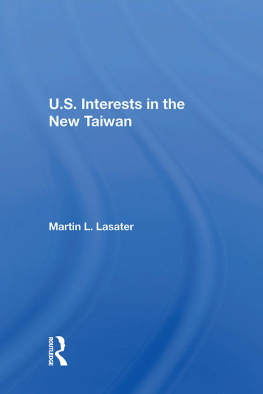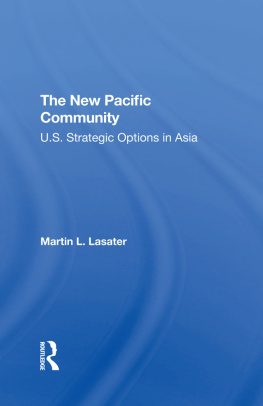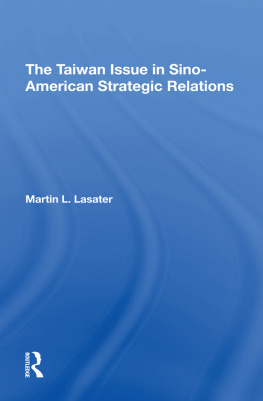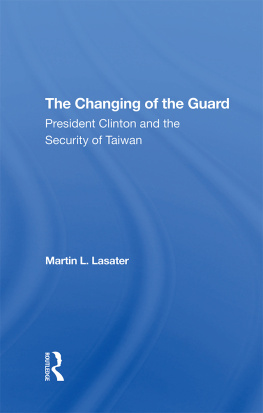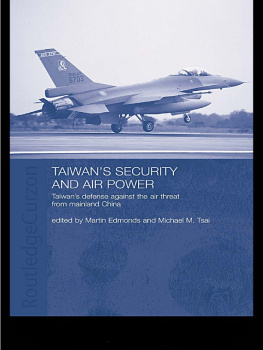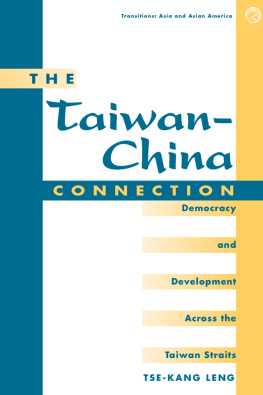Martin L. Lasater - U.s. Interests in the New Taiwan
Here you can read online Martin L. Lasater - U.s. Interests in the New Taiwan full text of the book (entire story) in english for free. Download pdf and epub, get meaning, cover and reviews about this ebook. year: 1993, publisher: Westview Press, genre: Politics. Description of the work, (preface) as well as reviews are available. Best literature library LitArk.com created for fans of good reading and offers a wide selection of genres:
Romance novel
Science fiction
Adventure
Detective
Science
History
Home and family
Prose
Art
Politics
Computer
Non-fiction
Religion
Business
Children
Humor
Choose a favorite category and find really read worthwhile books. Enjoy immersion in the world of imagination, feel the emotions of the characters or learn something new for yourself, make an fascinating discovery.
- Book:U.s. Interests in the New Taiwan
- Author:
- Publisher:Westview Press
- Genre:
- Year:1993
- Rating:5 / 5
- Favourites:Add to favourites
- Your mark:
- 100
- 1
- 2
- 3
- 4
- 5
U.s. Interests in the New Taiwan: summary, description and annotation
We offer to read an annotation, description, summary or preface (depends on what the author of the book "U.s. Interests in the New Taiwan" wrote himself). If you haven't found the necessary information about the book — write in the comments, we will try to find it.
U.s. Interests in the New Taiwan — read online for free the complete book (whole text) full work
Below is the text of the book, divided by pages. System saving the place of the last page read, allows you to conveniently read the book "U.s. Interests in the New Taiwan" online for free, without having to search again every time where you left off. Put a bookmark, and you can go to the page where you finished reading at any time.
Font size:
Interval:
Bookmark:

605 Third Avenue, New York, NY 10017
2 Park Square, Milton Park, Abingdon, Oxon OX14 4RN
Product or corporate names may be trademarks or registered trademarks, and are used only for identification and explanation without intent to infringe.
Lasater, Martin L
U.S. interests in the new Taiwan / by Martin L Lasater
p. cm.
Includes index.
ISBN 0-8133-8396-X
1. United States-Foreign relationsTaiwan. 2. TaiwanForeign relationsUnited States. I. Title.
E183.8.T3L4 1993
327.73041249dc20
CIP
ISBN 13: 978-0-3672-1524-8 (pbk)
- PART ONE
THE NEW TAIWAN- 2 Taiwan's Political Development
- The Kuomintang, or Nationalist Party
- Elections on Taiwan Through 1986
- Political Reform Under Lee Teng-hui
- Political Events in 1990
- Developments in 1991
- Conclusion
- Notes
- 3 Taiwan's Economic Development
- Stages of Development and Key Economic Policies
- Domestic Economy
- Economic Problems
- International Economic Relations
- Economic Relations with the PRC
- Future Economic Policies
- Conclusion
- Notes
- 4 Flexible Diplomacy
- A New Pragmatism
- Taiwan's Policy Toward Mainland China
- Conclusion
- Notes
- 5 The Security of Taiwan
- PRC Political Objectives in the Use of Force
- PRC Intentions to Use Force Against Taiwan
- Comparison of Military Capabilities
- Taiwan's Strategy of Deterrence
- Conclusion
- Notes
- 2 Taiwan's Political Development
- PART TWO
POLICY IMPLICATIONS FOR THE UNITED STATES- 6 Beyond Containment in Asia: U.S. Strategy and Policy in the 1990s
- Strategic Background
- U.S. Policy Toward Asia Under President Bush
- The Persian Gulf War
- The New World Order
- Sino-American Relations Under the Bush Administration, 1989-1991
- Conclusion
- Notes
- 7 U.S. Interests in the Republic of China
- U.S. Interests Defined
- U.S. Interests in Peace in the Taiwan Strait
- Other U.S. Interests in Taiwan
- The International System
- U.S. Interests in Taiwan's Alternative Futures
- Conclusion
- Notes
- 8 Policy Recommendations and Conclusions
- The United States and the "New" Taiwan
- Future U.S. Policy Toward Taiwan
- Conclusion
- Notes
- 6 Beyond Containment in Asia: U.S. Strategy and Policy in the 1990s
- PART ONE THE NEW TAIWAN
- 2 Taiwan's Political Development
- The Kuomintang, or Nationalist Party
- Elections on Taiwan Through 1986
- Political Reform Under Lee Teng-hui
- Political Events in 1990
- Developments in 1991
- Conclusion
- Notes
- 3 Taiwan's Economic Development
- Stages of Development and Key Economic Policies
- Domestic Economy
- Economic Problems
- International Economic Relations
- Economic Relations with the PRC
- Future Economic Policies
- Conclusion
- Notes
- 4 Flexible Diplomacy
- A New Pragmatism
- Taiwan's Policy Toward Mainland China
- Conclusion
- Notes
- 5 The Security of Taiwan
- PRC Political Objectives in the Use of Force
- PRC Intentions to Use Force Against Taiwan
- Comparison of Military Capabilities
- Taiwan's Strategy of Deterrence
- Conclusion
- Notes
- 2 Taiwan's Political Development
- PART TWO POLICY IMPLICATIONS FOR THE UNITED STATES
- 6 Beyond Containment in Asia: U.S. Strategy and Policy in the 1990s
- Strategic Background
- U.S. Policy Toward Asia Under President Bush
- The Persian Gulf War
- The New World Order
- Sino-American Relations Under the Bush Administration, 1989-1991
- Conclusion
- Notes
- 7 U.S. Interests in the Republic of China
- U.S. Interests Defined
- U.S. Interests in Peace in the Taiwan Strait
- Other U.S. Interests in Taiwan
- The International System
- U.S. Interests in Taiwan's Alternative Futures
- Conclusion
- Notes
- 8 Policy Recommendations and Conclusions
- The United States and the "New" Taiwan
- Future U.S. Policy Toward Taiwan
- Conclusion
- Notes
- 6 Beyond Containment in Asia: U.S. Strategy and Policy in the 1990s
Font size:
Interval:
Bookmark:
Similar books «U.s. Interests in the New Taiwan»
Look at similar books to U.s. Interests in the New Taiwan. We have selected literature similar in name and meaning in the hope of providing readers with more options to find new, interesting, not yet read works.
Discussion, reviews of the book U.s. Interests in the New Taiwan and just readers' own opinions. Leave your comments, write what you think about the work, its meaning or the main characters. Specify what exactly you liked and what you didn't like, and why you think so.

